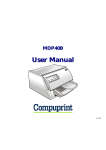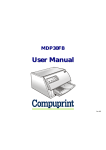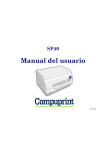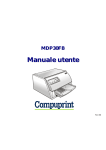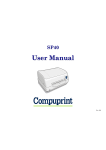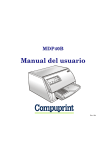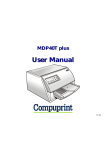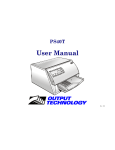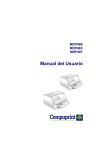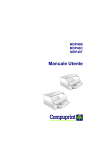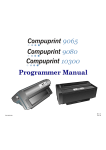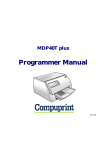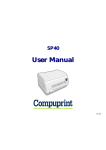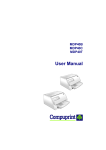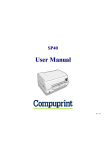Download Seiko Group FB300 User's Manual
Transcript
FB300 User Manual Rev. 001 Table of Contents Table of Contents ................................................. ii Printer Presentation ............................................. 1 Unpacking the Printer .......................................... 3 Printer Parts.......................................................... 4 Front view ................................................................. 4 Rear View ................................................................. 5 Printer Installation................................................ 6 Choosing a Suitable Location................................... 6 Installing the Paper Stand ........................................ 7 Installing the Power Cable........................................ 9 Installing the Ribbon Cartridge ............................... 10 Paper Handling ................................................... 12 Loading Paper ........................................................ 12 Loading Cut sheet and Multiparts....................... 12 Loading fanfold paper ......................................... 15 The Operator Panel ............................................ 18 Function keys.......................................................... 18 Display .................................................................... 20 Leds ........................................................................ 21 Software Driver Selection .................................. 22 Connection to the Host ...................................... 23 Setting the Interface Parameters ........................... 24 Parallel Interface ................................................. 24 Serial Interface .................................................... 24 Printing a Test Page ...........................................26 Printer Setup .......................................................28 Printing the Printer Setup Forms............................ 28 Filling in the Printer Setup Forms ........................... 31 Reading the Preprinted Forms ............................... 31 Printer Setup Flow Chart ........................................ 32 Setup Parameters................................................... 33 Offset Adjustments ................................................. 42 Troubleshooting .................................................45 Clearing Paper Jams.............................................. 45 Print Quality Problems............................................ 48 Hexadecimal Dump ................................................ 49 Paper Specifications...........................................50 Cut Sheets.............................................................. 51 Fanfold Paper ......................................................... 52 Technical Specifications ....................................53 FCC Notes.............................................................. 56 Canadian D.O.C. Radio Interference Regulation... 56 EEC Regulations .................................................... 56 Printer Presentation This dot-matrix printer is a multi-purpose printer for counter applications. Its compact structure is designed to be integrated in an ergonomic environment. The printer provides a high level of reliability, form-handling accuracy and data integrity. Its main features are: • Printing on different types paper: cut sheets, multiparts and fanfold paper • High print pressure for multipart documents • High print quality supplied by a 24 wire print head • High reliability paper handling The straight paper path allows the printing on particular documents such as multipart forms. • Automatic paper thickness adjustment The print head detects automatically the paper thickness for correct printing on any type of document. • Easy paper handling The cut sheets are placed on the front table by the operator and the printer loads it without any other user intervention. The paper ejection towards the front or the rear of the printer allows an easy access to the printed document. For the fanfold paper the printer offers the zero tear-off feature, which allows a paper handling without waste of paper, and the paper parking feature. 1 • Automatic switching between cut sheets and fanfold paper If the paper path is empty (i.e. the fanfold paper is in the first line position), when inserting a cut sheet into the printer, it is automatically loaded after the printer automatically parked the fanfold paper. The fanfold paper can then be loaded again simply pressing the LOAD/PARK key. • Automatic document alignment feature The printer checks automatically the alignment of the top margin and the left margin of the document and adjusts it, if necessary. The printout is therefore performed correctly independently from the paper loading position. • Storage of four complete configurations for instant recall • Standard parallel and serial interface and automatic switch-over function. • Easy printer setup • Supported emulations: IBM Proprinter XL24E, XL24E AGM, 2390+ and Epson 570 2 Unpacking the Printer Together with the printer the following items are included in the shipment box: Notify any damage to your supplier. • Paper stand • Ribbon cartridge • Power cable • CD-ROM with the printer documentation and drivers. Always keep the packing material in a safe place as you must repack the printer into it, when you need to move it. 3 Printer Parts Never remove any printer part unless it is expressly indicated in this manual. Front view O p erato r P anel P rinter C over P aper S tan d 4 Rear View R ear cover 5 Printer Installation Choosing a Suitable Location Consider the following points when you choose the location for your printer: • The distance between the printer and the host computer must not exceed the length of the interface cable; • The location must be sturdy, horizontal and stable; • Your printer must not be exposed to direct sunlight, extreme heat, cold, dust or humidity; • You need an AC power outlet compatible with the plug of the printer’s power cord. The voltage of the outlet must match the voltage shown on the printer’s Name Plate; • When printing on standard paper formats, the paper is partially ejected on the rear side of the printer. Make sure that behind the printer there is sufficient clearance to correctly move the paper; • Make sure that behind the printer there is sufficient clearance to easily load the fanfold paper; • Make sure that the power and interface cables do not hamper the fanfold paper while it is loaded into the printer. 6 Installing the Paper Stand 1. Open the printer cover. 2. Match the hooks on the lower side of the paper stand with the clefts on the printer front part. 7 3. Holding the paper stand oblique insert the hooks into the printer clefts. 4. Lower the paper stand to horizontal position making sure that the two holders on both sides are correctly inserted into the corresponding slots. Press the paper stand down until it clips into place. 5. Close the printer cover. 8 Installing the Power Cable 1. Find the power cable connector and the rating plate on the rear side of the printer. Make sure that your power supply matches the power rating of the printer. In case the power rating does not correspond DO NOT CONNECT THE PRINTER TO THE MAINS. Consult your dealer for help. Always use a grounded outlet. 2. Insert the power cable into the connector on the printer and the other end into a convenient mains outlet. 3. Press the key on the operator panel to power the printer on. LQ 9 Installing the Ribbon Cartridge To install the ribbon cartridge, the printer must be powered on. 1. Remove the cartridge from its bag. Turn the tension knob in the direction of the arrow to tighten the ribbon. 2. Open the printer cover, the print head moves to the ribbon installation position. 10 3. Hold the ribbon cartridge slightly inclined with the ribbon mask in front of the print head. 4. Insert the ribbon cartridge into the print head carriage, leading the cartridge pins into the fixing guides. In this way you assure the correct ribbon mask position in front of the print head. Push the cartridge onto the print carriage until it clicks into place. 5. Turn the tension knob in the direction of the arrow to tighten the ribbon. 6. Close the printer cover. 11 Paper Handling This printer is designed for versatile an reliable paper handling. The flat-bed mechanism allows the handling of special documents, such as multiple invoices, postcards, labels and tickets. The print head detects the paper edges automatically, the sheet can therefore be inserted in any position within the detection area according to the rules described in the following paragraph. The paper alignment sensors determine the alignment of the upper and left paper margins, adjusting them if necessary. The print head determines the thickness of the documents and matches its position. Loading Paper Loading Cut sheet and Multiparts • The inserted documents must not have folds, tears, pins, clips, staples or any foreign material. C lip P in Te a r S ta p le F old F ore ig n m ate ria l If you insert damaged documents or paper with foreign material, you can seriously damage the printer. 12 When inserting the paper into the printer, keep the following points in mind: • The document may not exceed the limits of the paper stand. R ight Lim it Left Lim it • The documents having a width of at least 90 mm must be inserted on the left hand side over the grooved area on the paper stand. The documents must cover the whole grooved area, otherwise the printer will not accept the paper. NO OK 13 • To load the documents having a width of less than 90 mm: − make sure that in the program menu the MANUAL LOADING item is enabled. − hold the paper against the left paper guide of the paper support while inserting it into the printer 14 Loading fanfold paper The fanfold paper is loaded form the rear of the printer. 1. Lower the two levers of the rear printer cover and unhook it from the printer. 2. Unhook the right tractor moving the tractor lever towards the outside of the printer. 15 3. Open the two tractor covers. 4. Insert the perforation of the fanfold paper on the left paper tractor. Close the tractor door. Insert the paper on the right paper tractor and close the tractor door. The upper margin of the inserted paper should not exceed the tractors. 16 Make sure, that the paper is inserted correctly (straight). 5. Move the right paper tractor towards the right to slightly tighten the paper. Lock the tractor in that position moving the tractor lever towards the inside of the printer. Make sure, that the paper is not too taught, otherwise it may tear. 6. Hook the rear tractor cover into the corresponding slots (1) and push it against the printer until both rear tractor levers (2) firmly hook into the printer. 2 1 7. Press LOAD/PARK to load the paper into the printer. To remove the paper from the printer follow the above sequence backwards. 17 The Operator Panel The operator panel is located on the front left side of the printer and is composed of function keys and leds with which you can easily check the printer status and select the functions as described below: P1 MICRO FEED P2 LF FF P3 LQ LOAD PARK P4 PROGRAM ONLINE Function keys Turns the printer on or off. To turn the printer off, this key must be pressed for at least 3 seconds. LQ Toggles between Letter Quality and Draft printing mode. This key is active, when the printer is offline or when the printer is online and no print data are in the buffer. When pressed while powering the printer on, selects the printer setup mode. See “Printer Setup” later in this manual. 18 LOAD PARK If the paper path is empty, the fanfold paper is loaded into the printer (LOAD function). This function is performed when the printer is online or offline. If paper is loaded in the printer, pressing this key, the PARK function is performed: • a single sheet is loaded in the printer, pressing this key it is ejected; • if the fanfold paper is loaded in the printer, pressing this key it is parked of the printer is offline (ON LINE indicator off) or when the printer is online (ON LINE indicator on) and there are no data to be printed. The PARK key has different effects depending on the selection for the PARK MODE item in the Program Setup. See the description of this item later in this manual. ↑ ↓ LF FF Moves the fanfold paper forward in microsteps or continuously when keeping the key pressed. This key is enabled, when the printer cover is open. Moves the fanfold paper backwards in microsteps or continuously when keeping the key pressed. This key is enabled, when the printer cover is open. Moves the paper one line. If fanfold paper is loaded, the key moves it forward one page. If a single sheet is loaded, it is moved forward for the selected page length. 19 PROGRAM Selects one of the available configurations (P1, P2, P3 and P4 or a configuration couple P1/P3 or P2/P4) if the PROGRAM LOCKED parameter is not enabled. This key is active, when the printer is offline or when the printer is online and no print data are in the buffer. When pressed while powering the printer on, selects the offset adjustment page. See “Offset Adjustment” later in this manual. ON LINE Toggles the printer between online and offline status. When pressed while powering the printer on, selects the Self Test printout. See “Printing a Test Page” in this manual. Display The display normally shows the printer name or is used to indicate fault states of the printer. 20 Leds POWER On, if the printer is powered on. LQ On, if the Letter Quality mode is selected. P1, P2, P3, P4 Indicate the currently selected configuration both in normal printing mode and during the Printer Setup procedure. See “Printer Setup” later in this section. If the INTERFACE TYPE function is set to auto+blink, when line 1 (parallel interface) is selected for data transmission, the P1 indicator blinks. If the INTERFACE TYPE function is set to auto+blink, when line 2 (serial interface) is selected for data transmission, the P2 indicator blinks. In case of fault condition P1, P2, P3 and P4 blink. ON LINE On, if the printer is online. Off, if the printer is offline. Blinks, when receiving printing data from host. In case of a printer fault during the initialization of the LQ, P1, P2, P3, P4 and ON LINE indicators blink contemporaneously. Turn the printer off and on again. If the problem is not solved, call the Customer Service. 21 Software Driver Selection At this point it is necessary to configure your printer for your application package. The installation procedures depend upon the host environment. Together with the printer you receive a CD-ROM containing the printer drivers for the Windows environment. This printer supports the Plug&Play facility in the Windows95/98/2000® environment. If you want to install the printer in the Windows environment, insert the CD-ROM and follow the instructions. 22 Connection to the Host This printer can be connected to the host by means of a parallel standard Centronics or bidirectional IEEE 1284 type interface or by means of the serial RS232C interface. Proceed as follows: 1. Make sure that both the host and the printer are turned off. 2. With the help of the following figure identify the connector for the interface you want to connect and insert the cable firmly into it. 3. Fix the parallel interface cable by means of the corresponding hooks or the serial cable tightening the screws on either side of the connector. S E R IA L (L in e 2) PA R A LLE L (L in e 1) Make sure, that the interface cables do not hamper the fanfold paper while it is loaded into the printer. 23 Setting the Interface Parameters Parallel Interface The parameters set for the parallel interface match most of the most common environments and the printer can be used immediately after the connection to the host. In case you need to modify the standard parameters see “Printer Setup” later in this section. Serial Interface Because of the great variety of the possible connection configurations, when you use the serial interface you will need to set the parameters accordingly. To assure a correct functioning of the printer connected through the serial interface, the transmission parameters set for the printer must match the values set for the host. Check the interface settings on the host and proceed as follows: 1. Press the LQ key while powering the printer on and keep it pressed until all leds turn briefly on. The printer enters the Setup mode. 2. Insert a blank sheet in A4 or Letter format. The printer loads the sheet and stops. The P1, P2, P3 and P4 leds are lit. 3. Press the PROGRAM key once. The P1, P2, P3 and P4 leds are unlit. 4. Press the LQ key. The printer prints the first configuration sheet. 24 5. To change the values of the serial interface parameters, fill in the marker ( ) beside the value you want to set with a black or blue ball-point pen or a fiber-pen. Do not use pencils. W ORD LENG TH BA U D R AT E PA R IT Y B IT ( ) ( ) d is a b le d * e n a b le d ( ) ( ) d is a b le d * e n a b le d ( ) ( ) DTR X O N /XO F F * X O N /X O F F + D T R ( ) If more than one value is set for a parameter, the printer ignores these parameters and maintains the currently set value. Do not fill in the marker beside the title of the preprinted form, otherwise the printer will not be able to read that page. 6. Once the serial interface parameters have been signed, insert the sheet back into the printer. 7. The printer reads the selected values on the configuration sheet and sets them. The settings are confirmed by a # symbol printed on the left of the corresponding marker. The printer then returns to normal functioning mode. For a complete description of the printer setup procedure see the paragraph “Printer Setup” later in this manual. 25 Printing a Test Page It is now useful to test, if the printer has been correctly installed. For this purpose print the self test page as follows. 1. Press the ON LINE key while powering the printer on and hold the key pressed until all leds turn briefly on. 2. Insert a single sheet in A4 or Letter format. The printer prints the Self-Test page. Check that the printout is correct. The following printout example shows also the printer setup default values. SELF TEST FB300 : Code Version Vx.x CONFIGURATION SETUP DISPLAY LANG. PROGRAM PROGRAM LOCKED ERROR BUZZER JOB BUZZER SECURITY MODE AUTO GAP OFFSET GET EDGE QUOTE SKIP PERFORATION TEAR ADJUST xxxxxxxx CharGen:xxxxxxxx ver. x.xx English progr.1 no 1 beep No beep enabled +0.000 mm 1/2” disabled +0,00 mm 26 INTERFACE TYPE INPUT BUFFER AUTOFEED SIGNAL SLCT-IN SIGNAL IGNORE PE BUFFER CONTROL ROBUST XON WORD LENGTH BAUD RATE PARITY BIT automatic 16 Kb disabled disabled enabled XON/XOFF enabled 8 bit 9600 bps none PROGRAM SETUP PROTOCOL FONT HORIZONTAL PITCH VERTICAL PITCH LOCK FORM LENGTH LEFT MARGIN RIGHT MARGIN TOP MARGIN BOTTOM MARGIN IBM C-SET IBM COMPRESS EPSON C-SET NATION C-SET CODE PAGE LINE MODE WRAP MODE SLASHED ZERO PRINT DIRECTION EJECT ON FF CUT SHEET EJECT PARK MODE TEAR MODE MANUAL LOADING ALIGN MODE GAP MODE VERT.POS 1/10” VERT.ADJ 1/60” HORIZ.POS 1/10” HORIZ.ADJ 1/60” PROGRAM 1 IBM XL24E Draft 10 cpi 6 lpi no lock A4 0 0 96 0 0 IBM set 1 17.1 cpi graphic USA CP437 LF=LF, CR=CR autowrap no sw control yes on front manual imm. manual disabled fast auto 0 0 0 0 PROGRAM 2 EPSON 570 Draft 10 cpi 6 lpi no lock A4 0 0 96 0 0 IBM set 1 17.1 cpi graphic USA CP437 LF=LF, CR=CR autowrap no sw control yes On front manual imm. manual disabled fast auto 0 0 0 0 27 PROGRAM 3 IBM XL24E Draft 10 cpi 6 lpi no lock #lines 72 0 96 0 0 IBM set 1 17.1 cpi graphic USA CP437 LF=LF, CR=CR autowrap no sw control yes on front manual imm. manual disabled fast auto 0 0 0 0 PROGRAM 4 EPSON 570 Draft 10 cpi 6 lpi no lock #lines 72 0 96 0 0 IBM set 1 17.1 cpi graphic USA CP437 LF=LF, CR=CR autowrap no sw control yes on front manual imm. manual disabled fast auto 0 0 0 0 Printer Setup The default configuration of this printer matches most of the commonly used environments, but it may be necessary to change some printer parameters. For this purpose it is necessary to use preprinted forms to be used with the printer in configuration mode. The following is the complete description of the Setup Procedure. The detailed description of the parameters that can be set on the various preprinted forms are described in the “Setup Parameters” paragraph, later in this manual. To enter the Printer Setup Mode press and hold the LQ key for at least 1 second while powering the printer on. The printer enters the Setup Mode. Printing the Printer Setup Forms If you already have the preprinted forms for the printer setup, go to “Filling in the Printer Setup Forms” later in this manual. Insert a blank sheet in A4 or Letter format. The printer loads the sheet and stops. The P1, P2, P3 and P4 leds are lit. The ON LINE, PROGRAM and LQ keys are enabled. If the LQ key is pressed immediately after the printer enters in Setup Mode, all printer setup modules are printed. 28 If you press the ON LINE key: • the printer self-test is printed. See “Printing a Test Page” before in this manual. In this way it is possible to check the current printer parameters. • once the self-test is finished, the printer remains in Setup Mode. If you press the PROGRAM key: • the Px leds change and you can select the Setup Page you want to print as follows: P1 P2 P3 P4 P1 P2 P3 P4 P1 P2 P3 P4 All setup pages Configuration page Program 1 page P1 P2 P3 P4 P1 P2 P3 P4 P1 P2 P3 P4 Program 2 page Program 3 page Program 4 page = lit = unlit The printer setup forms contain all printer parameters and the values that can be set. The current value is indicated by an asterisk (*). For a detailed description of the parameters and the settings see “Setup Parameters” later in this manual. 29 Each printer setup form is identified by a marker in the upper left corner of the page as follows: Configuration Setup Program 1 Program 3 Program 2 Program 4 If you press the LQ key: The printing of the printer setup forms starts. The forms are printed according to the selection made with the PROGRAM key. If you select one of the Program couples P1/P3 or P2/P4 you can define one parameters set for printing on cut sheets and one for fanfold. P1 and P2 define the values for printing on cut sheets, whereas P3 and P4 define the printing parameters for the fanfold paper. The program couples may be selected only if the same emulation is selected for the two programs. The selection of the Program Setup is made simply pressing the PROGRAM key. When passing from one Program Setup to another, the printer resets before setting the parameters as defined in the new program setup. 30 Filling in the Printer Setup Forms To change the values of the parameters, fill in the marker ( ) beside the value you want to set with a black or blue ball-point pen or a fiber-pen. Do not use pencils. AU TO FE ED S IG N AL ( ) ( ) d is a b le d * SL C T -IN SIG N AL BU FF E R C O N TR O L en a b le d ( ) ( ) d is a b le d * en a b le d ( ) ( ) D TR XO N /XO F F * X O N /X O F F + ( ) If more than one value is set for a parameter, the printer ignores these parameters and maintains the currently set value. Do not fill in the marker beside the title of the preprinted form, otherwise the printer will not be able to read that page. Reading the Preprinted Forms When the Printer Setup Forms have been filled in, insert them back into the printer. The printer is able to recognize the Setup Forms by means of the markers on these pages. The printer reads the values marked for the various parameters and configures the printer accordingly. The settings are confirmed by a # symbol printed on the left of the corresponding marker. 31 Printer Setup Flow Chart + P rin ter P ow ered-off N o rm al M od e LQ P1 P2 P3 P4 P R OGR AM ON L I N E LQ S e lf Te s t P1 P2 P3 P4 P R OGR AM LQ + P1 P2 P3 P4 + P R OGR AM LQ P1 P2 P3 P4 + P R OGR AM LQ P1 P2 P3 P4 + P R OGR AM LQ P1 P2 P3 P4 P R OGR AM LQ 32 ! Setup Parameters The following is a listing of the setup parameters. Configuration Sheet Setup Parameter Values Description RESTORE TO MFG no The selected values are not set to factory defaults. all The values set in all printer setups are reset to factory default values. config The values set in the configuration setup are reset to factory default values. prog.1, prog. 2, prog.3, prog 4 The values set in the corresponding program setup are reset to the factory default values. DISPLAY LANG. English, Italian, German, French, Spanish Defines the language of the display messages. PROGRAM progr.1, progr.2, progr.3, progr.4, progr.1/3, progr.2/4 Defines the default Program Setup or Setup couple. The program couples may be selected only if the same emulation has been selected for the two setups. PROGRAM LOCKED no, yes Locks the program setup selection. In case the lock is ‘enabled’ the program setup cannot be changed pressing the PROGRAM key. ERROR BUZZER 1 beep, no beep Selects the behavior of the buzzer in case of an error. JOB BUZZER no beep, 1 beep, continuous Selects the behavior of the buzzer when a new print job begins: no signal (no beep), one beep (1 beep) or a continuous beep (continuous). 33 Setup Parameter Values Description INTERFACE TYPE parallel, serial, automatic, auto+blink Selects the interface type. In case of ‘automatic’ the interface type is selected by the printer depending on data coming from host. When the auto+blink item is selected, the P1 and P2 leds blink to indicate which interface is selected: P1 blinks when the parallel interface is selected, whereas P2 blinks, when the serial interface is selected. INPUT BUFFER 1 Kb, 8 Kb, 16 Kb, 32 Kb Selects the buffer size. IGNORE PE enabled, disabled Selects whether the printer signals the paper empty condition (disabled) or not (enabled). AUTOFEED SIGNAL disabled, enabled The parallel interface uses (enabled) or does not use (disabled) the AUTOFEED signal. SLCT-IN SIGNAL disabled, enabled The parallel interface uses (enabled) or does not use (disabled) the SELECT-IN signal. BUFFER CONTROL DTR+SRTS, SRTS, XON/XOFF, XON/XOFF+DTR+SRTS Selection of the buffer protocol. ROBUST XON enabled, disabled Perform the Robust XON (enabled) or not (disabled). WORD LENGTH 7 bit, 8 bit Sets the number of the data bits. BAUD RATE 600 - 38400 bps Sets the data transfer rate. PARITY BIT even, odd, none Selects the parity control for the data. 34 Setup Parameter Values Description SECURITY MODE enabled, disabled Enables or disables the security actions that assure protection against paper jams. If disabled, the paper handling is faster. AUTO GAP OFFSET -0,075 mm, -0.050 mm, -0.025 mm, +0.000 mm, +0.025 mm, +0.050 mm, +0.075 mm, +0.100 mm Sets the automatic gap offset to one of the given values. GET EDGE QUOTE 0/2”, 1/2”, 2/2”, 3/2”, 4/2”, Sets the position in which the left paper edge is checked. If set 5/2”, 6/2”, 7/2” to 0, the check is performed at the first line. The other values correspond to the physical distance from the first line. SKIP PERFORATION disabled, enabled If the movement of the paper perforation under the print head is critical, select enabled to avoid the paper to get torn. The print head lifts up while the paper perforation passes through. If disabled, the print head stays in position. TEAR ADJUST -0,85 mm, -0,56 mm, -0,28 mm, +0,00 mm, +0,28 mm +0,56 mm, +0,85 mm Sets the paper tear-off position by aligning the paper with the tear-off edge. 35 PROGRAM 1 PROGRAM 2 PROGRAM 3 PROGRAM 4 Setup Parameter Values Description PROTOCOL EPSON 570, IBM X24E, IBM X24E AGM, IBM 2390 Defines the printer protocol. FONT Draft, Courier, OCR-B, Gothic, Prestige, Present, OCR-A, Script, Boldface Selects the font. HORIZONTAL PITCH 10 cpi, 12 cpi, 15 cpi, 17 cpi, Selects the character spacing in characters per inch (cpi). 20 cpi VERTICAL PITCH 5 lpi, 6 lpi, 8 lpi, Selects the line spacing in lines per inch (lpi). LOCK no lock, font, hor. pitch, font+hor. pitch The following selections made via operator panel may be locked: font, horizontal pitch (hor.pitch), or both the font and horizontal pitch (font+hor. pitch). The locked settings cannot be changed via software commands. FORM LENGTH # lines, A4, letter, A5, legal Sets the page length in number of lines or standard formats A4, Letter, A5 or Legal. If you select # lines, you must indicate the number of lines you want to set in the scheme below this selection. The values range between 0 and 255. To set the values combine the numbers considering that the first line corresponds to the hundreds, the second line to the tens and the third line to the units. See the example below. 36 Example: How to set the form length to 82 lines: 100 x 10 x 0 ( ) ( ) # lines 1 2 ( ) ( ) ( ) 1x ( ) ( ) ( ( 3 ( ) A4 4 ( ) ( ) letter A5 5 6 ( ) ( ) ( ) ( ) ( ) ( ) ( ) legal 7 8 9 ( ) ( ) ( ( ( ( FORM LENGTH ( ) ( ) ( ) ( ) ( ) Setup Parameter Values Description LEFT MARGIN 10 x 1x Sets the left margin in number of columns. The values range between 0 and 90. To set the values combine the numbers considering that the first line corresponds to the hundreds, the second line to the tens and the third line to the units. See the example below. Example: How to set the Left Margin to 20. LEFT MARGIN 1 ( ) 2 10 x 0 ( ) ( 3 ( ) 4 ( ) 5 ( ) 6 ( ) 7 ( ) 8 ( ) 9 ( ) 1x ( ( ( ) ( ) ( ) ( ) ( ) ( ) ( ) ( ) ( ) ( Setup Parameter Values Description RIGHT MARGIN 100 x 10 x 1x Sets the right margin in number of columns. The values range between 0 and 190. The physical position of margin depends on the current character spacing. To set the values combine the numbers considering that the first line corresponds to the hundreds, the second line to the tens and the third line to the units. See the example below: 37 Example: How to set the Right Margin to 101. RIGHT MARGIN 0 100 x ( ) 1 10 x ( 1x ( ) 2 3 4 5 6 7 8 9 ( ) ( ) ( ) ( ) ( ) ( ) ( ) ( ) ( ) ( ( ) ( ) ( ) ( ) ( ) ( ) ( ) ( ) ( ( ( ( Setup Parameter Values Description TOP MARGIN 10 x 1x Sets the top margin in number of lines. The values range between 0 and 90. To set the values combine the numbers considering that the first line corresponds to the hundreds, the second line to the tens and the third line to the units. See the example below. Example: How to set the Top Margin to 15. TOP MARGIN 0 ( ) 1 10 x 1x ( ) ( 3 ( ) 4 ( ) 5 ( ) 6 ( ) 7 ( ) 8 ( ) 9 ( ) ( ) ( ) ( ) ( ) ( ( Setup Parameter 2 ( ) ( ) ( ) ( ) ( ) ( Values BOTTOM MARGIN 10 x 1x Description Sets the bottom margin in number of lines. The values range between 0 and 90. To set the values combine the numbers considering that the first line corresponds to the hundreds, the second line to the tens and the third line to the units. See the example below. 38 Example: How to set the bottom margin to 34 lines: 1 ( ) 2 ( ) 3 1x ( ) ( ) ( ) ( ( ) ( 4 ( ) 5 ( ) 6 ( ) 7 ( ) 8 ( ) 9 ( ) ( BOTTOM MARGIN 0 10 x ( ) ( ) ( ) ( ) ( ) ( ) ( Setup Parameter IBM C-SET IBM COMPRESS Values IBM set 1, IBM set 2 17.1 cpi, 20 cpi EPSON C-SET NATION C-SET italic, graphic USA, FRANCE, GERMANY, ENGLAND, DENMARK1, SWEDEN, ITALY, SPAIN1, JAPAN, NORWAY, DENMARK2, SPAIN2, LATIN A1 CODE PAGE CP437, CP437G, 96GREEK, CP850, Selects the code page for both the IBM and the CP851, CP852, CP853, CP855, CP857, EPSON emulations. CP858, CP860, CP862, CP863, CP864, CP865, CP866, CP867, CP876, CP877, CP1098, CP1250, CP1251, CP1252, GOST, TASS, MAZOWIA, CP437SL, UKRAIN, 8859/1, 8859/2, 8859/3, 8859/4, 8859/5, 8859/6, 8859/7, 8859/8, 8859/9, 8859/15, ROMAN-8, ID 12, CP874, ID 14, ID 17, SANYO, KU, PHILIP 39 Description Selects the IBM character set. Selects the pitch for the compressed mode printing in IBM emulation. Selects italic or graphic Epson character set. Selects the national character sets. Setup Parameter Values Description LINE MODE LF=LF, CR=CR If the printer receives a LF code (LF), it only performs a line feed. If the printer receives a CR code (CR), it only performs a carriage return. CR=LF+CR If the printer receives a CR code (CR), it perf


























































